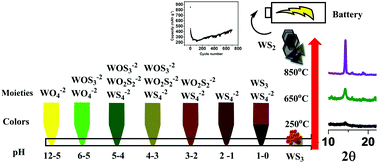当前位置:
X-MOL 学术
›
New J. Chem.
›
论文详情
Our official English website, www.x-mol.net, welcomes your
feedback! (Note: you will need to create a separate account there.)
Large-scale surfactant-free synthesis of WS2 nanosheets: an investigation into the detailed reaction chemistry of colloidal precipitation and their application as an anode material for lithium-ion and sodium-ion batteries†
New Journal of Chemistry ( IF 2.7 ) Pub Date : 2019-12-23 , DOI: 10.1039/c9nj04662c Poonam Sharma 1, 2, 3, 4 , Ananya Kumar 2, 3, 4, 5 , Siresha Bankuru 1, 2, 3, 4 , Jayanta Chakraborty 1, 2, 3, 4 , Sreeraj Puravankara 2, 3, 4, 5
New Journal of Chemistry ( IF 2.7 ) Pub Date : 2019-12-23 , DOI: 10.1039/c9nj04662c Poonam Sharma 1, 2, 3, 4 , Ananya Kumar 2, 3, 4, 5 , Siresha Bankuru 1, 2, 3, 4 , Jayanta Chakraborty 1, 2, 3, 4 , Sreeraj Puravankara 2, 3, 4, 5
Affiliation

|
Transition metal dichalcogenides (TMDCs) are versatile 2D materials that have many important applications including their use as battery materials for energy storage. However, very few reports are available in the open literature on the scalable synthesis of these materials. In this work, an easy and versatile wet synthesis method for large scale preparation of tungsten disulfide (WS2) is reported. Although such methods are sometimes referred to in textbooks as the ‘industrial methods’ for WS2 manufacturing, a detailed synthesis process is not reported in the literature. The chemistry of the process, as revealed in this work, is also very different from that hitherto known. In this work, we clearly show that the sulfurization of WO42− is found to occur through several stable intermediates such as WOS32− and WO2S22−. Sulfurization is also found to occur through H2S upon lowering the pH. The entire process needs very careful monitoring as various side reactions and the corresponding pH are identified during the sulfurization process, which is crucial for product purity and yield. Apart from the sulfurization process, we also thoroughly explored the calcination step and hence have provided a complete process for obtaining the best pristine quality, scalable WS2 sheets. When evaluated as an anode material for Li-ion (LIB) and Na-ion (NIB) batteries, an initial capacity of about 400 mA h g−1 at 1C rate is obtained. A drastic capacity fading due to polysulphide formation is found to be more critical in the NIB system. The rate capability of pristine, bulk, scalable WS2 in LIBs is quite high (250 mA h g−1) even at 5C rate (2.1 A g−1). The initial results on carbon-coated WS2/C as the anode in LIBs show remarkable capacity recovery and retention, regaining the initial reversible capacity of about 450 mA h g−1 after 700 cycles at 1C.
中文翻译:

WS 2纳米片的大规模无表面活性剂合成:对胶体沉淀的详细反应化学及其作为锂离子和钠离子电池负极材料的应用的研究†
过渡金属二硫化碳(TMDC)是通用的2D材料,具有许多重要的应用,包括用作储能的电池材料。但是,公开文献中很少有关于这些材料的可扩展合成的报告。在这项工作中,报道了一种用于大规模制备二硫化钨(WS 2)的简便通用的湿法合成方法。尽管此类方法有时在教科书中称为WS 2制造的“工业方法” ,但文献中未报告详细的合成过程。正如这项工作所揭示的,该过程的化学性质也与迄今已知的化学性质有很大不同。在这项工作中,我们清楚地表明WO 4 2−的硫化发现其通过几种稳定的中间体如WOS 3 2-和WO 2 S 2 2-发生。还发现在降低pH值时,硫化氢会通过H 2 S发生。整个过程需要非常仔细的监控,因为在硫化过程中会识别出各种副反应和相应的pH,这对于产品的纯度和收率至关重要。除了硫化工艺之外,我们还彻底探索了煅烧步骤,因此为获得最佳原始质量,可扩展的WS 2板材提供了完整的工艺。当评估为锂离子(LIB)和钠离子(NIB)电池的负极材料时,初始容量约为400 mA hg -1以1C的速率获得。人们发现,在NIB系统中,因形成多硫化物而导致的急剧容量衰减更为关键。原始,散装的,可扩展WS的速率能力2在LIBS是相当高的(250毫安汞柱-1),即使在5℃速率(2.1克-1)。以碳包覆的WS 2 / C作为LIB阳极的初始结果显示出显着的容量恢复和保留,在1C下进行700次循环后恢复了约450 mA hg -1的初始可逆容量。
更新日期:2020-01-09
中文翻译:

WS 2纳米片的大规模无表面活性剂合成:对胶体沉淀的详细反应化学及其作为锂离子和钠离子电池负极材料的应用的研究†
过渡金属二硫化碳(TMDC)是通用的2D材料,具有许多重要的应用,包括用作储能的电池材料。但是,公开文献中很少有关于这些材料的可扩展合成的报告。在这项工作中,报道了一种用于大规模制备二硫化钨(WS 2)的简便通用的湿法合成方法。尽管此类方法有时在教科书中称为WS 2制造的“工业方法” ,但文献中未报告详细的合成过程。正如这项工作所揭示的,该过程的化学性质也与迄今已知的化学性质有很大不同。在这项工作中,我们清楚地表明WO 4 2−的硫化发现其通过几种稳定的中间体如WOS 3 2-和WO 2 S 2 2-发生。还发现在降低pH值时,硫化氢会通过H 2 S发生。整个过程需要非常仔细的监控,因为在硫化过程中会识别出各种副反应和相应的pH,这对于产品的纯度和收率至关重要。除了硫化工艺之外,我们还彻底探索了煅烧步骤,因此为获得最佳原始质量,可扩展的WS 2板材提供了完整的工艺。当评估为锂离子(LIB)和钠离子(NIB)电池的负极材料时,初始容量约为400 mA hg -1以1C的速率获得。人们发现,在NIB系统中,因形成多硫化物而导致的急剧容量衰减更为关键。原始,散装的,可扩展WS的速率能力2在LIBS是相当高的(250毫安汞柱-1),即使在5℃速率(2.1克-1)。以碳包覆的WS 2 / C作为LIB阳极的初始结果显示出显着的容量恢复和保留,在1C下进行700次循环后恢复了约450 mA hg -1的初始可逆容量。











































 京公网安备 11010802027423号
京公网安备 11010802027423号